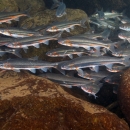As a way to mitigate for fish losses from habitat destruction, fish passage fish passage
Fish passage is the ability of fish or other aquatic species to move freely throughout their life to find food, reproduce, and complete their natural migration cycles. Millions of barriers to fish passage across the country are fragmenting habitat and leading to species declines. The U.S. Fish and Wildlife Service's National Fish Passage Program is working to reconnect watersheds to benefit both wildlife and people.
Learn more about fish passage barriers, and over-harvest, millions of Pacific salmon and steelhead are reared in and released from hatcheries in the Columbia River basin and the west coast of North America. Unfortunately, Pacific salmon reared in hatcheries can become different - for example genetically or behaviorally - relative to their wild fish ancestors, which can reduce their usefulness as a mitigation tool. To address these concerns, QET biologists have for more than a decade investigated ecological differences between wild and hatchery steelhead in Abernathy Creek. Ecological research here has focused on studying feeding behavior and behavioral interactions (interference competition) between juveniles during freshwater residence, as well as using mark-recapture methods and population modeling to evaluate potential differences in distribution, survival, and mitigation timing. We have also collaborated with colleagues in other research programs here at Abernathy and partners in the Pacific region to understand the underlying basis (e.g., genetic, physiological, or nutritional) for observed ecological differences between hatchery and wild steelhead.
Research

